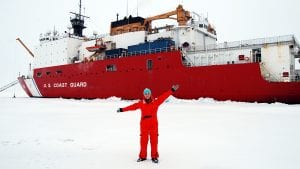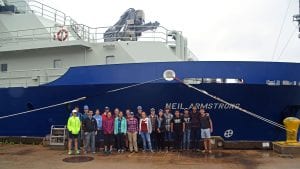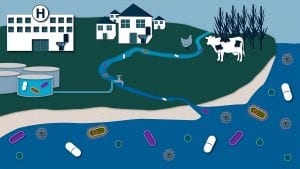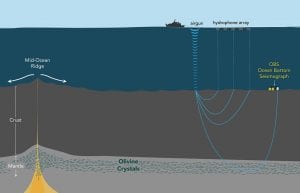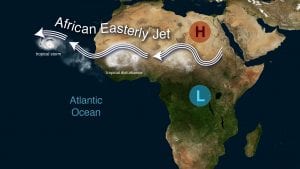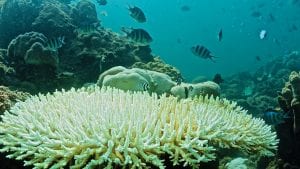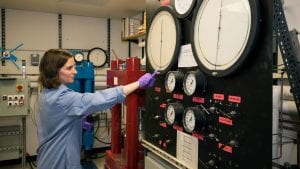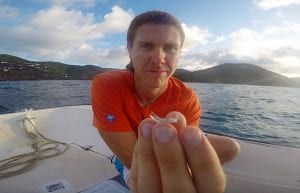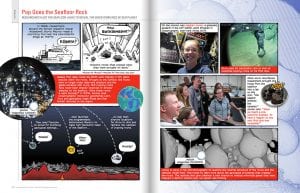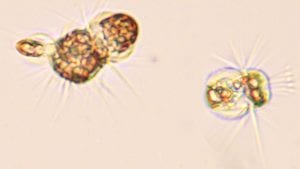Students
- People Directory
- Ombuds
- Humans of WHOI
- Ocean Pioneers
- Profiles & Interviews
- Testimonies & Briefings
- Awards & Recognition
- B.H. Ketchum Award
- B.H. Ketchum Award Recipients
- Dr. Don Anderson
- Dr. Candace Oviatt
- Dr. James Cloern
- Dr. Richard Garvine
- Dr. John Farrington
- Dr. Nancy Rabalais
- Dr. Willard Moore
- Dr. Ronald Smith
- Dr. Christopher Martens
- Dr. Scott Nixon
- Dr. Daniel Lynch
- Dr. William Boicourt
- Dr. Alasdair McIntyre
- Dr. John S. Allen
- Dr. Thomas H. Pearson
- Dr. Michael Moore
- Prof. Edward D. Goldberg
- Call for Nominations
- B.H. Ketchum Award Recipients
- Henry Bryant Bigelow Medal in Oceanography
- Henry Melson Stommel Medal
- Mary Sears Women Pioneers in Oceanography Award
- WHOI scientists recognized for outstanding achievement
- B.H. Ketchum Award
- Community Committees
- Obituaries
A Change Has Come in the Arctic
On a long voyage across the Arctic Ocean, an MIT-WHOI graduate students finds chemical clues that climate change has already had impacts on the region.
Students Get Their Sea Legs
Woods Hole Oceanographic Institution is known for its ocean-going research. But some incoming graduate students in the MIT-WHOI Joint Program may never have set foot a large research ship before. A new orientation cruise aboard the research vessel Neil Armstrong is introducing students to shipboard life and oceanographic research.
The Bacteria on Your Beaches
The widespread use of antibiotics is increasing the spread of antibiotic-resistant bacteria—perhaps into the ocean, too.
How Is the Seafloor Made?
An ultrasound for the Earth? Using sound waves, a graduate student peers into the crystalline texture of the tectonic plates that cover our planet’s surface.
Unearthing Long-Gone Hurricanes
A graduate student at Woods Hole Oceanographic Institution tracks a trail of clues left behind on the seafloor by hurricanes as they stream across the ocean.
A Double Whammy for Corals
Scientists know that gradually rising ocean temperatures can push corals past a threshold and cause them to bleach. But combine this chronic stress with an acute short-term weather shift, and…
Taking Earth’s Inner Temperature
Woods Hole Oceanographic Institution wasn’t an obvious fit for Emily Sarafian. “I always felt a little out of place here, because I don’t study the ocean, really,” said Sarafian, a…
How Do Fish Find Their Way?
An MIT-WHOI Joint Program graduate student is exploring how tiny larvae hatched in the open ocean find their way to coral reefs where they settle down and live.
Pop Goes the Seafloor Rock
WHOI scientists used the human-occupied submersible Alvin and the autonomous underwater vehicle Sentry to explore a surprising discovery: gas-filled volcanic rocks on the seafloor that “pop” when brought up to the surface.
The Amazing Acquired Phototroph!
There are autotrophs, such as plants, that can make their own food. There are heterotrophs, such as animals, that consume other organisms. And then there are curious organisms called mixotrophs, which can do both, switching how they get food depending on the conditions in their environment.

